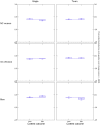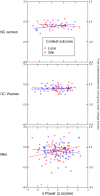Endocrine and aggressive responses to competition are moderated by contest outcome, gender, individual versus team competition, and implicit motives
- PMID: 28750061
- PMCID: PMC5531467
- DOI: 10.1371/journal.pone.0181610
Endocrine and aggressive responses to competition are moderated by contest outcome, gender, individual versus team competition, and implicit motives
Abstract
This study examined hormonal responses to competition in relation to gender, social context, and implicit motives. Participants (N = 326) were randomly assigned to win or lose in a 10-round, virtual face-to-face competition, in same-sex individual- and team-competition contexts. Saliva samples, taken before and twice after the competition, were assayed for testosterone (T), estradiol (E), progesterone (P), and cortisol (C). Implicit needs for power (nPower) and affiliation (nAffiliation) were assessed with a picture-story exercise before the competition. Aggression was measured via the volume at which participants set noise blasts for their opponents. Men competing individually and women competing as teams showed similar T increases after winning. C was differentially associated with outcome in the team matches, with higher post-match cortisol for winning women, and an opposite effect for male teams. Analyses including implicit motives indicated that situational variables interacted with motivational needs in shaping hormonal responses to competition: in naturally cycling women, nPower predicted T increases after winning and T and E decreases after losing. In men, nPower predicted T increases after losing and decreases after winning. In male teams, nPower predicted C increases after losing, but not after winning, whereas in individual competitions, nPower was a general negative predictor of C changes in women. nAffiliation predicted P increases for women competing as teams, and P decreases for women competing individually. Aggression was higher in men, losers, and teams than in women, winners, and individuals. High aggression was associated with high baseline C in women competing individually and with low baseline C and C decreases in women competing as teams and in men generally. Our findings suggest that while situational and gender factors play a role in hormonal responses to competition, they also depend on their interplay with motivational factors. They also suggest that while aggression is strongly affected by situational factors in the context of a competition, it has no direct association with motivational and hormonal correlates of dominance (nPower, T, E) and instead is associated with (mostly) low levels of C.
Conflict of interest statement
Figures








Similar articles
-
The effects of competition and implicit power motive on men's testosterone, emotion recognition, and aggression.Horm Behav. 2017 Jun;92:57-71. doi: 10.1016/j.yhbeh.2017.04.005. Epub 2017 May 2. Horm Behav. 2017. PMID: 28455183
-
Testosterone responses to competition predict future aggressive behaviour at a cost to reward in men.Psychoneuroendocrinology. 2009 May;34(4):561-70. doi: 10.1016/j.psyneuen.2008.10.018. Epub 2008 Dec 2. Psychoneuroendocrinology. 2009. PMID: 19054624
-
Salivary cortisol changes in humans after winning or losing a dominance contest depend on implicit power motivation.Horm Behav. 2006 Mar;49(3):346-52. doi: 10.1016/j.yhbeh.2005.08.013. Epub 2005 Nov 7. Horm Behav. 2006. PMID: 16274692 Clinical Trial.
-
Testosterone, cortisol, and human competition.Horm Behav. 2016 Jun;82:21-37. doi: 10.1016/j.yhbeh.2016.04.004. Epub 2016 Apr 19. Horm Behav. 2016. PMID: 27103058 Review.
-
Testosterone and human behavior: the role of individual and contextual variables.Curr Opin Psychol. 2018 Feb;19:149-153. doi: 10.1016/j.copsyc.2017.03.021. Epub 2017 Apr 6. Curr Opin Psychol. 2018. PMID: 29279215 Review.
Cited by
-
Low competitive status elicits aggression in healthy young men: behavioural and neural evidence.Soc Cogn Affect Neurosci. 2021 Nov 15;16(11):1123-1137. doi: 10.1093/scan/nsab061. Soc Cogn Affect Neurosci. 2021. PMID: 33959776 Free PMC article.
-
Testosterone:cortisol ratio as a predictor of podium in adolescent rowing athletes.Heliyon. 2023 Nov 14;9(11):e22315. doi: 10.1016/j.heliyon.2023.e22315. eCollection 2023 Nov. Heliyon. 2023. PMID: 38053894 Free PMC article.
-
Social Construction and Evolutionary Perspectives on Gender Differences in Post-traumatic Distress: The Case of Status Loss Events.Front Psychiatry. 2022 May 16;13:858304. doi: 10.3389/fpsyt.2022.858304. eCollection 2022. Front Psychiatry. 2022. PMID: 35651822 Free PMC article.
-
The effect of contest participation and contest outcome on subsequent prosocial behavior.PLoS One. 2020 Nov 3;15(11):e0240712. doi: 10.1371/journal.pone.0240712. eCollection 2020. PLoS One. 2020. PMID: 33141829 Free PMC article.
-
The Relationship Between Multidimensional Motivation and Endocrine-Related Responses: A Systematic Review.Perspect Psychol Sci. 2021 May;16(3):614-638. doi: 10.1177/1745691620958008. Epub 2021 Jan 29. Perspect Psychol Sci. 2021. PMID: 33513308 Free PMC article.
References
-
- Mazur A. A biosocial model of status in face-to-face primate groups. Soc Forces. 1985;64:377–402.
-
- Wingfield JC, Hegner RE, Dufty AM, Ball GF. The "Challenge Hypothesis": Theoretical Implications for Patterns of Testosterone Secretion, Mating Systems, and Breeding Strategies. Am Nat. 1990;136:829–46.
-
- Oliveira AG, Oliveira RF. Androgen responsiveness to competition in humans: the role of cognitive variables. Neuroscience and Neuroeconomics. 2014;3:19–32.
-
- Schultheiss OC. The hormonal correlates of implicit motives. Social and Personality Psychology Compass. 2013;7(1):52–65. doi: 10.1111/spc3.12008 - DOI
-
- Wrangham RW, Peterson D. Demonic males: Apes and the origins of human violence: Houghton Mifflin Harcourt; 1996.
MeSH terms
Substances
LinkOut - more resources
Full Text Sources
Other Literature Sources
Miscellaneous

